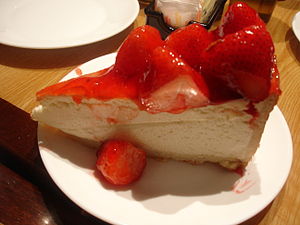On July 30th, cheesecake lovers around the country will celebrate National Cheesecake Day by voting for their favorite flavors, entering their own in contests for prizes, and especially, by eating this deliciously creamy treat. Most people have a favorite kind of cheesecake. It may be one created with the family recipe handed down for generations or the one made at the deli down the street. It could feature blueberries or cherries, chocolate or caramel, or be so fantastic in its own right, that it needs no embellishment.
With so many varieties and variations it is logical to wonder if there is a point where a cheesecake is no longer really a cheesecake, but some other kind of dessert. So, how can you tell if the slice on your plate is actually cheesecake? Here is a quick overview of all things cheesecake.
While there are no real hard and fast rules about cheesecake, there is one absolute requirement; it must feature a layer that is made from some kind of soft fresh cheese. It will also have a base upon which this cheesy layer rests that can be a crust, like those made from graham crackers, some kind of pastry or biscuit, or even a sponge cake. Cheesecake can come baked or unbaked and may or may not have a topping of some kind above the cheese layer. Therefore, as long as there is a base and a layer made primarily of cheese, the slice on your plate qualifies as cheesecake, at least according to today’s definition.
However, if we were in ancient Greece, the slice on your plate would be considered cheesecake, but it would be very different. The first known versions of cheesecake were simple concoctions containing only four ingredients: flour, honey, and cheese, and had no crust. The ingredients were mixed together and baked. The ancient Romans are the ones who first separated the cheese layer from the base, filling pastries with a cheesy filling. They are also the ones who would spread the concept of cheesecake around the world enabling that first cake made with cheese to evolve into the cheesecake of today.
So, in order to be a cheesecake, it must have a cheese layer, but does it matter what kind of cheese that layer is made from? The simple answer, it depends who you ask. In some European countries, like Germany, cheesecakes are made with quark, which is similar to curds or cottage cheese. In Italy, cheesecakes are made with ricotta. Here in the U.S., most cheesecake is made using cream cheese but even that is not as clear cut as it may sound. For example, while Philadelphia-style cheesecake does use cream cheese to produce its light and creamy texture, New York style cheesecake relies on heavy cream and sour cream to create its dense consistency and creamy texture.
To wrap up, you will know your cheesecake is a cheesecake if it has a base of crust or pastry, paired with a creamy layer that may, or may not contain actual cheese, but will have some form of dairy product as its main ingredient. From there, pretty much anything goes! You can top your cheesecake with fruit like cherries or blueberries, drizzle it with chocolate or caramel, or decorate and embellish it with just about anything you desire, and it will still be a cheesecake.
Looking for a great way to celebrate National Cheesecake Day? Try one of these great recipes from Fill Your Plate that feature local Arizona ingredients and flavors.
Related articles
- Cherries on Top! (fillyourplate.org)
- Perfect Pecans (fillyourplate.org)
- Get Down With Dairy This Month (fillyourplate.org)


